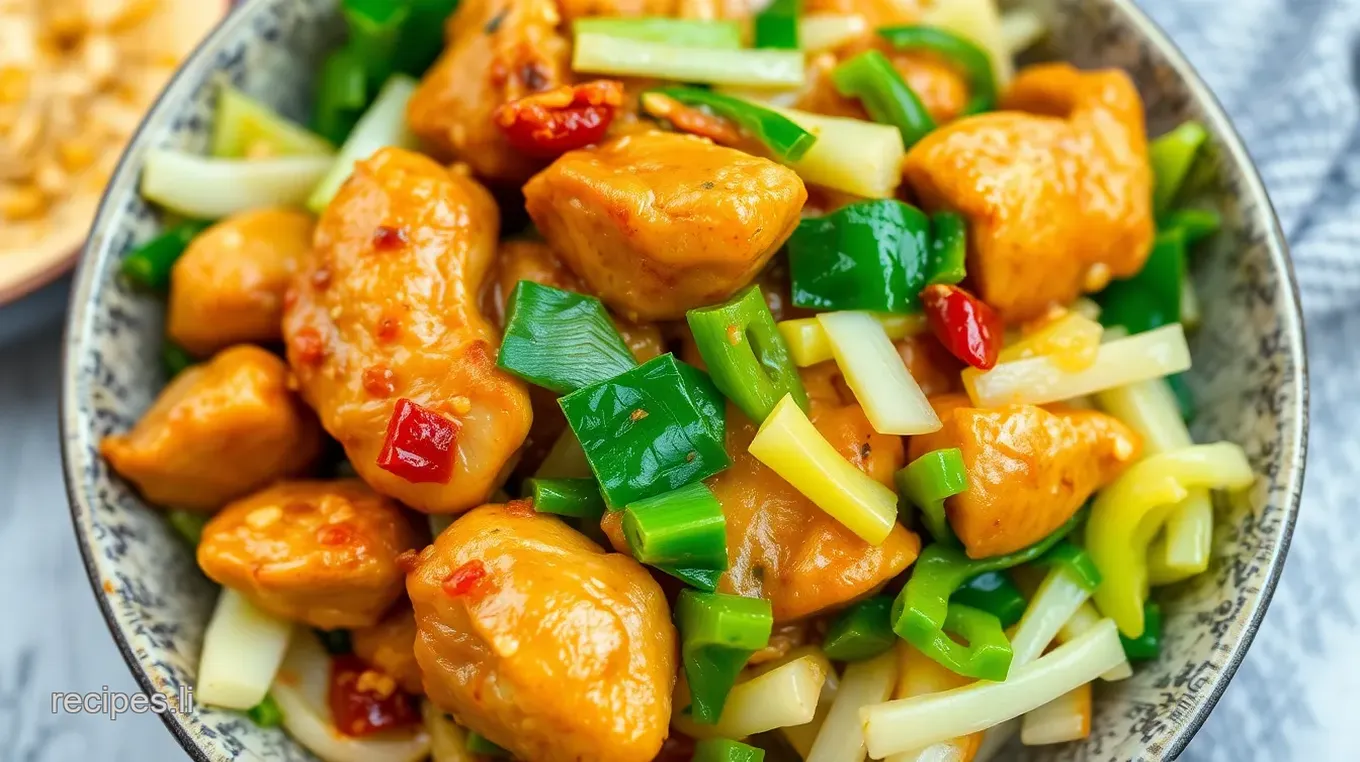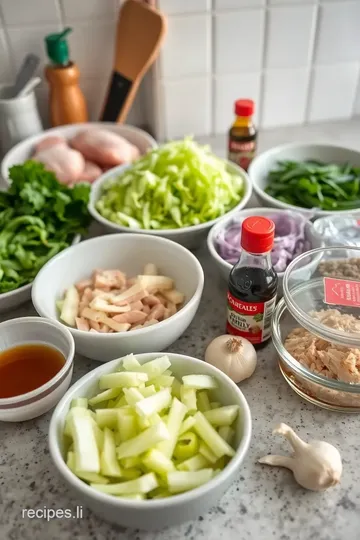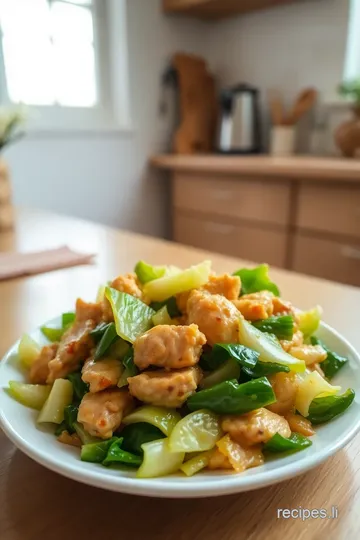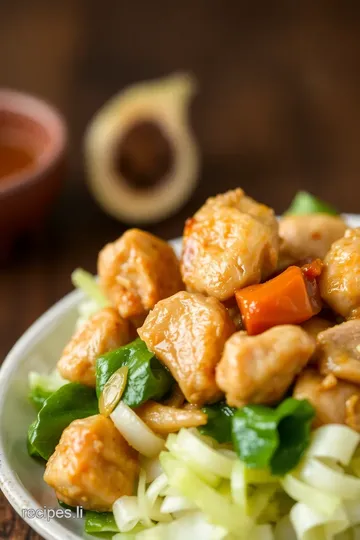Stir-Fry Chicken with Savory Cabbage Delight
Craving something delicious? This Stir-Fry Chicken with Savory Cabbage Delight is my go-to weeknight meal! Easy to make and bursting with flavor, it's a hit with the whole family.

- A Taste of Home: Stir-Fry Chicken with Savory Cabbage Delight
- Recipe Overview: A Comforting Tradition
- Key Benefits: Crunchy and Delightfully Healthy
- Cooking Made Simple
- Essential Ingredients Guide for Your Next Stir-Fry Night
- Mastering the Art of Stir-Fry Chicken with Savory Cabbage Delight
- Pro Tips & Secrets for Savory Perfection
- Perfect Presentation: Make It Pop!
- Storage & Make-Ahead: Keep It Fresh
- Creative Variations: Spice It Up
- Complete Nutrition Guide: Keeping It Balanced
- Expert FAQ Solutions: Cooking Concerns Sorted
- Recipe Card
A Taste of Home: Stir-Fry Chicken with Savory Cabbage Delight
Let me take you back to the first time i tried making a stir-fry at home. i was a college student, fueled by ramen noodles and takeout, but craving something fresh and different.
I stumbled upon a chicken stir-fry recipe online, and it featured this gorgeous blend of chicken, colorful veggies, and yes—cabbage! honestly, i was a bit intimidated.
Cooking with cabbage sounded fancy, but what i didn’t know then was that this easy stir-fry chicken dish would become my go-to.
Fast forward to today, and here i am, sharing my all-time favorite: stir-fry chicken with savory cabbage delight.
This dish hits all the right notes—quick, vibrant, and oh-so-satisfying! it takes the humble cabbage and elevates it to superstar status.
So, whether you're an experienced chef or a total newbie, buckle up as we dive into this delightful recipe!
Recipe Overview: A Comforting Tradition
Did you know stir-fry cooking has roots in ancient china? this method, originating from cooking in a wok, has been around for centuries.
It's all about using high heat and quick cooking techniques to preserve the flavor and crunch of your ingredients. nowadays, stir-fries can be found in kitchens across america, and they’ve made a splash in modern asian-inspired cuisine .
So, how long will this dinner take? prep time is about 15 minutes , and you’ll have a freshly cooked meal on the table in just 10 to 12 minutes .
That’s right! in a little over 25 minutes, you can whip up a healthy chicken meal that serves four people.
And the best part? most ingredients won’t break the bank.
Key Benefits: Crunchy and Delightfully Healthy
Let's talk benefits. first, this stir-fry is packed with nutrition. chicken breast provides lean protein, while cabbage is not only crunchy but also loaded with vitamins and fiber.
There’s something so comforting about crispy stir-fry vegetables mingling with the savory sauce—a whole balanced meal prepared in one pan!
This dish is also versatile. whether it’s a busy weeknight dinner idea or a festive gathering, savory cabbage dishes can easily adapt.
Plus, it’s family-friendly! kids love the colorful veggies stir-fried alongside the chicken, and you can always throw in some plant-based stir-fry alternatives if you like.
And, let me tell you a secret—using high heat cooking really brings out depth in flavors. If you’ve never stir-fried before, you’re in for a treat!
Cooking Made Simple
Thinking about giving this a go? Just gather fresh ingredients, marinate your chicken, and follow my step-by-step stir-fry instructions below. You’ll be amazed how easy and satisfying it is!
So, let’s not keep you waiting. Ready to cook? Here’s what you’ll need for our Stir-Fry Chicken with Savory Cabbage Delight :
This dish marries tender chicken, crunchy cabbage, and a zesty sauce like no other. it's a celebration of flavors and textures that’s perfect for any day of the week.
Give it a whirl, and you might find it becomes a family favorite too!

Essential Ingredients Guide for Your Next Stir-Fry Night
Oh my gosh, if you haven't tried a stir-fry chicken with savory cabbage delight yet, you’re seriously missing out! it’s a quick way to whip up a dish that’s not just tasty but healthy too.
To make your cooking experience flawless, it's super important to understand the essential ingredients and gather your tools.
Premium Core Components
Let’s kick things off with the premium core components you’ll need!
- Chicken Breast: Aim for 1 lb (450g) of boneless, skinless chicken breast, cut into bite-sized pieces. To check for quality, look for a pink hue with no dark spots. Store in the fridge, and it should be good for 1-2 days .
- Green Cabbage: Around 2 cups (150g) , thinly sliced, gives that crunchy texture. Choose heads that feel heavy and firm. Store in a dry place; it can last for about 1-2 weeks in the crisper drawer.
- Fresh Ginger and Garlic: A teaspoon of minced ginger and a couple of garlic cloves brings tons of flavor! They should feel firm and fragrant. They can go into your fridge for about 1-2 weeks but use them fresh when you can for the best taste.
Signature Seasoning Blend
When it comes to signature seasoning , the magic happens here!
- Soy Sauce: You’ll need 2 tablespoons (30ml) for marinating and 3 tablespoons (45ml) for the stir-fry. Look for a dark, rich color; it should smell savory and slightly salty.
- Oyster Sauce: Just 2 tablespoons (30ml) for that umami hit we all love. If you can’t find it, hoisin can work too.
- Honey or Brown Sugar: Add 1 tablespoon (15g) for a hint of sweetness. Choosing organic can sometimes make a difference in flavor.
Smart Substitutions
Let’s face it, sometimes you don’t have everything on hand. No biggie! Here are some smart substitutions .
- Don’t have chicken? Try tofu or tempeh for a plant-based stir-fry alternative .
- Out of soy sauce? Use tamari or coconut aminos instead.
- Forget fresh garlic? A pinch of garlic powder will suffice in a pinch.
Kitchen Equipment Essentials
Now let’s chat about the kitchen equipment essentials .
- Wok or Large Skillet: If you can get a wok, that's the bomb for high-heat cooking. But a large skillet will do just fine too.
- Chef's Knife: You’ll want a good sharp knife to slice through that chicken and veggies. Believe me, it makes life easier!
- Measuring Tools: Make sure you can measure those ingredients. It helps to keep everything balanced!
Cooking Tips at a Glance
Here’s a handy tip: prep ahead ! marinate your chicken in the morning to allow those flavors to soak in.
And don’t skimp on the fresh ingredients ; they make a huge difference in flavor balance and texture.
When you’re ready to cook, keep your high heat cooking tips in mind. This quick cooking locks in the deliciousness as you achieve that golden brown texture on your chicken.
The Transition to Cooking Your Dish
All this talk about ingredients has probably got you itching to get cooking. So let’s dive into those step-by-step stir-fry instructions! Trust me, you’ll have this easy stir-fry chicken on the table before you can say, “What’s for dinner?” This is totally a family-friendly meal that can make you look like the star chef of the house!
Get ready to impress everyone with your one-pan chicken recipes that not only save time but bring smiles and full bellies to the table.
So, grab your ingredients, and let’s make that stir-fry chicken with savory cabbage delight happen! your kitchen adventure awaits!
Mastering the Art of Stir-Fry Chicken with Savory Cabbage Delight
So, you’re in the mood for something quick, healthy, and packed with flavor? well, look no further! let’s dive into the world of stir-fry chicken with savory cabbage delight .
This dish seriously embodies quick asian recipes that don't just save time but also pack a punch in taste.
Essential Preparation Steps
Before you toss ingredients into your pan, we gotta talk about mise en place , folks. it’s just a fancy way of saying “everything in its place.
” grab all your ingredients, chop ‘em up, and organize your workspace. it’ll make the cooking process a breeze.
Oh, and let’s not forget about time management . this dish won't take long but knowing what to do first can save you precious minutes.
Aim for prep time: 15 minutes, cook time: 10- 12 minutes , and boom, you're looking at a total time of about 25- 27 minutes .
Stay safe in the kitchen—keep a clean workspace and watch those knife skills! if you're cutting veggies, always curl your fingers under to avoid accidents.
Honestly, nothing ruins a dinner party faster than a trip to the er, right?
Step-by-Step Process
Ready to cook? Here’s your game plan:
-
Marinate the Chicken : Mix your chicken with soy sauce, cornstarch, and sesame oil. Let it sit for at least 10 minutes while you work on the veggies.
-
Prepare the Sauce : Mix soy sauce, oyster sauce, honey, and rice vinegar in a bowl. Set it aside; you'll need it soon.
-
Stir-fry the vegetables : heat up 2 tablespoons of vegetable oil in a wok. toss in minced garlic and ginger for around 30 seconds —it should smell heavenly.
Add your sliced onion and bell peppers next, stir-frying until they're nice and tender, about 2- 3 minutes . finally, add the cabbage and stir-fry just until it starts to wilt (about 2 minutes ).
-
Cook the chicken : push the veggies to one side and add the marinated chicken. stir it until it turns golden brown and is cooked through, which should take around 5- 6 minutes .
When it’s ready, mix everything together!
-
Combine and Serve : Pour that delicious sauce over the chicken and veggies, and let it bubble for an additional 1- 2 minutes . Serve hot over rice or noodles.
Expert Techniques
Now, let’s talk professional cooking methods, shall we? the key here is high heat —it locks in those flavors and makes everything sizzle just right.
Feel free to toss in some crunchy stir-fry vegetables like carrots or snap peas for extra texture. don’t forget to taste as you go! adjusting flavors is what makes your meal truly special.
Common mistakes? Well, overcooking is a “no-no.” When you stir-fry, you're looking for that perfect doneness—a slight crunch is what you want.
Success Strategies
Alright, time to level up your cooking game. remember to prep ahead; marinating your chicken early on gives it a rich flavor.
And if you’ve got fresh ingredients—like in this stir-fry chicken recipe—you’re golden! fresh cabbage can elevate your dish from good to amazing .
If you want to make-ahead options, you can marinate the chicken overnight. just be sure not to overcook it when you finally fry it up.
The best results come from balancing your stir-fry's texture and flavor.
Additional Information
To wrap things up, stir-fry chicken with savory cabbage delight is more than just a meal; it’s a delicious journey through asian-inspired cuisine right in your kitchen.
Plus, it’s incredibly family-friendly and works wonderfully as a weeknight dinner idea. next time you’re rushed for time but still want something nutritious, remember this easy stir-fry chicken recipe.
You'll be ready to impress your crew in no time, all while savoring every bite of your crunchy cabbage stir-fry!
And with that, let’s keep exploring how to make our culinary adventures even better!

Pro Tips & Secrets for Savory Perfection
Making a stir-fry chicken with savory cabbage delight is easier than you may think. honestly, it’s all about putting your heart into it.
Here are my favorite little secrets that will take your stir-fry to the next level.
First off, always marinate your chicken for at least 10 minutes. use soy sauce, cornstarch, and a splash of sesame oil for a flavorful kick.
This little technique gives your chicken that tender zing you’re craving. for an extra layer of flavor, toss in some minced garlic or ginger right into the marinade.
Just remember to taste as you go . you can always adjust the seasonings. oh, and don’t rush it – let that chicken soak up all that goodness!
If you're short on time, prep your veggies in advance. slice and store them in the fridge until you’re ready to stir-fry.
Trust me, this time-saving hack makes weeknight dinners stress-free. you can whip up a meal like this in under 30 minutes! oh, and the high heat? essential.
It creates that smoky flavor you get from stir-fry joints. plus, it keeps your veggies vibrant and crunchy.
Perfect Presentation: Make It Pop!
Okay, now that your stir-fry chicken with savory cabbage delight is cooked, let’s make sure it looks as good as it tastes.
Presentation matters, people! first off, use a big, shallow bowl to plate. create a little mound in the center with your stir-fry and let the edges spill over a bit.
Trust me, it looks gorgeous.
For garnish, sprinkle some toasted sesame seeds or chopped green onions on top. this not only adds a pop of color but also some crunch.
Color combinations matter too! pair your dish with bright carrots or vibrant red bell peppers. it’ll make your plate as inviting as your favorite takeout spot.
Storage & Make-Ahead: Keep It Fresh
Here’s the deal: if you find yourself with leftovers - score! just store your stir-fry in an airtight container. it’ll last about 3-4 days in the fridge.
If you’re looking for longer storage, pop it in the freezer for up to 3 months . just be mindful: when reheating, do so gently on low heat to prevent everything from becoming mushy.
We want that crispy goodness, not a soggy mess!
Pro tip: consider making a double batch on the weekend. You can have easy stir-fry chicken ready to go for those busy weeknights. You'll thank me later!
Creative Variations: Spice It Up
This stir-fry recipe is super flexible! what’s delightful about it is how you can really make it your own . want to use tofu? go for it! craving a kick? add some red chili flakes.
The beauty of a stir-fry is you can toss in whatever you have on hand. feeling seasonal? use grilled zucchini in the summer, or swap in root veggies like carrots or parsnips in winter.
Honestly, the sky's the limit!
Complete Nutrition Guide: Keeping It Balanced
Now, let’s talk about nutrition because who doesn’t want a healthy chicken meal ? each serving of this delectable dish is about 320 calories .
With 25g of protein , you’re not just filling up but also fueling your body right. balance is the name of the game; pair it with some brown rice or quinoa to give yourself a wholesome meal.
If you’re counting carbs, skip those and load up on extra veggies. Eating well doesn’t have to be complicated – simple stir-fry techniques deliver deliciously healthy options.
Expert FAQ Solutions: Cooking Concerns Sorted
Have questions? i've got answers! a common one is about the soy sauce. if you're sensitive to sodium, try using a low-sodium option or tamari for a gluten-free version.
If your chicken isn’t browning like mine, make sure your pan is hot enough. high heat is crucial for that stir-fry magic!
And here’s a fun tip: if you find the sauce too salty, add a little more honey or sugar to balance it out.
Conclusion: Get Cooking!
So there you have it – a recipe that’s not just tasty but also a canvas for your creativity. stir-fry chicken with savory cabbage delight is perfect for any night of the week .
With these tips in your back pocket, you’ll be dishing out delicious stir-fried chicken with vegetables in no time! now, what are you waiting for? get in the kitchen, and let’s whip up some incredible flavors!

Stir-Fry Chicken with Savory Cabbage Delight Card

⚖️ Ingredients:
- 1 lb (450g) boneless, skinless chicken breast, cut into bite-sized pieces
- 2 cups (150g) green cabbage, thinly sliced
- 1 cup (130g) bell peppers, sliced
- 1 small onion, thinly sliced
- 2 cloves garlic, minced
- 1 tablespoon fresh ginger, minced
- 2 tablespoons vegetable oil (30ml)
- 2 tablespoons soy sauce (30ml)
- 1 tablespoon cornstarch (8g)
- 1 teaspoon sesame oil (5ml)
- 3 tablespoons soy sauce (45ml)
- 2 tablespoons oyster sauce (30ml)
- 1 tablespoon honey or brown sugar (15g)
- 2 teaspoons rice vinegar (10ml)
🥄 Instructions:
- Step 1: In a mixing bowl, combine the chicken pieces, soy sauce, cornstarch, and sesame oil. Let marinate for at least 10 minutes while preparing vegetables.
- Step 2: In a small bowl, whisk together soy sauce, oyster sauce, honey (or brown sugar), and rice vinegar. Set aside.
- Step 3: Heat vegetable oil in a wok or large skillet over medium-high heat. Add the minced garlic and ginger, sauté for 30 seconds until fragrant.
- Step 4: Add sliced onion and bell peppers; stir-fry for 2-3 minutes until slightly tender. Incorporate the cabbage; stir-fry for an additional 2 minutes until just wilted.
- Step 5: Push the vegetables to one side of the pan. Add the marinated chicken to the other side, cooking until golden brown and no longer pink (about 5-6 minutes). Stir everything together.
- Step 6: Pour the prepared sauce over the stir-fry; cook for an additional 1-2 minutes until heated through. Serve immediately over rice or noodles.
Previous Recipe: How to Mix Flavorful Fish Seasoning in 5 Minutes: A Zesty DIY Delight!
Next Recipe: How to Make Sauté Shrimp & Scallops | Delightful Seafood Dish
